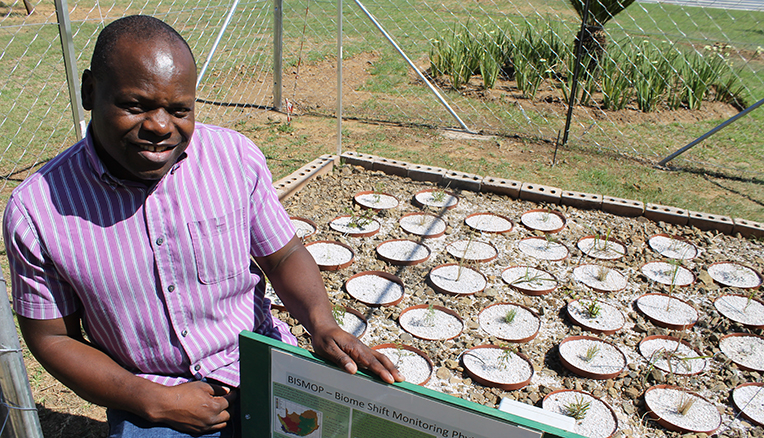South Africa, and more specifically the Free State, is known as a drought-stricken area. Invasive alien plants are gulping up much-needed water resources, draining our land.
Pollination ecologist, Dr Sandy-Lynn Steenhuisen, who is also expanding into invasive alien research, is conducting research on the reproductive ecology of exotic plant species in montane grasslands. As an affiliate of the Afromontane Research Unit (ARU) and Senior Lecturer in the Department of Plant Sciences at the University of the Free State (UFS), this research is conducted with her students and a host of collaborators from Rhodes University (Centre for Biological Control), Stellenbosch University (Centre for Invasion Biology), and the University of KwaZulu-Natal.
She says substantial funding is being made available for research on invasive species due to the extent of the problem nationally and globally. Their research is being funded and conducted in collaboration with plant ecology experts, Dr Kim Canavan (Rhodes University), Dr Grant Martin (Rhodes University), Prof David Richardson (Stellenbosch University), and Prof Colleen Downs (University of KwaZulu-Natal), as well as UFS postgraduate students Anthony Mapaura and Lehlohonolo Donald Adams, and UFS postdoctoral fellow, Dr Nicholas Le Maitre.
Besides working with a host of collaborators, the ARU was this year also invited to join the prestigious Mountain Invasion Research Network (MIREN), a global network of academics who are passionate about understanding the invasion of mountains by non-native species and its impact on local mountain ecologies.
Black Wattle makes rivers run dry
Alien plant species that often escape from planted gardens or plantations, thrive in disturbed, mismanaged and eroded areas. One of the biggest issues regarding alien plant invasion is that many people are not aware of the harmful effects it has on the environment, and that they continue to plant it or allow invaders to spread.
A large percentage of trees in urban South Africa are invasive alien trees. They dry out the soil and displace our native plants. Coming from other countries and without their former enemies or competitors, they flourish. Our indigenous plants are not used to these plants and are easily displaced.
An example of a very aggressive invasive alien plant in the region, and in South Africa as a whole, is Black Wattle. It uses excessive water, so bad that rivers run dry and riverbanks become eroded. It also chemically excludes many native plants from growing among them.

Anthony Mapaura’s research focuses on Nassella, an invasive alien grass in the elevated areas of the Eastern Cape mountains.
This plant is extremely difficult to control and is the cause of a large number of cattle dying. (Photo: Leonie Bolleurs)
This species is very hard to control. If you burn it or cut it off, it will grow back. In addition, it drops a great number of seeds into the soil, spreading without any difficulty.
Another invader, Yellow Firethorn, which is being investigated by master’s student Adams, invades high-elevation grassland areas, reducing grazing potential and ultimately leading to unproductive farmland and choked rivers.
“Our mountain grassland systems are not adapted to compete with the invasion of these alien trees. Since they are using excessive water resources, natural streams should return in many instances if they are removed,” says Dr Steenhuisen.
Nassella displacing indigenous plants
Mapaura focuses his doctoral study on an invasive grass genus, Nassella, originating from the Americas. Growing in the elevated areas of the Eastern Cape mountains, this species is the cause of a large number of cattle dying.
The plant, which is not palatable and consists mostly of fibre, is eaten by cattle – especially during dry seasons when there is not much natural grazing available. It is difficult to digest, forming a ball in the stomach of the animals that ultimately results in death.
“It is extremely difficult and costly to control, and natural grasses cannot compete with it. In Australia, many farmers have had to abandon their farms once these plants invaded, as the cost of control was higher than the value of the land. A similar situation could unfold in South Africa, and it’s a race to learn all we can about the ecology of this genus to inform policy and practice,” says Dr Steenhuisen.
The solution, fighting for survival
She said to effectively address these invasions, we need to understand everything about the reproductive ecology of the plants to develop specific biological or chemical control methods to target and destroy the plant at an appropriate life stage. We also need to know if the plants are using native animals (if not just wind and water) to pollinate their flowers and spread their seeds. “Organisations investigating the effectiveness of biological control agents and chemical products will be able to use our research data on the plants’ ecology to focus efforts on specific life stages,” she adds.
Invasive alien plants also contribute to South Africa losing the genetic integrity of certain native plants with which they hybridise. For example, pure genetic lines of native white stinkwood trees are potentially mixing with exotics and hybrids, adding to a loss of diversity and genetic purity – a project being undertaken by postdoctoral fellow, Dr Le Maitre.
Dr Steenhuisen urges South Africans to plant the genetically pure South African white stinkwood trees, especially since alien species and hybrids are often sold by garden centres as if they were the indigenous species.
Dr Vincent Ralph Clark, Head of the Afromontane Research Unit at the UFS, has a vision to start a nursery for high-elevation indigenous plants. “A great number of nurseries do not supply pure indigenous trees, but hybrids,” says Dr Steenhuisen.